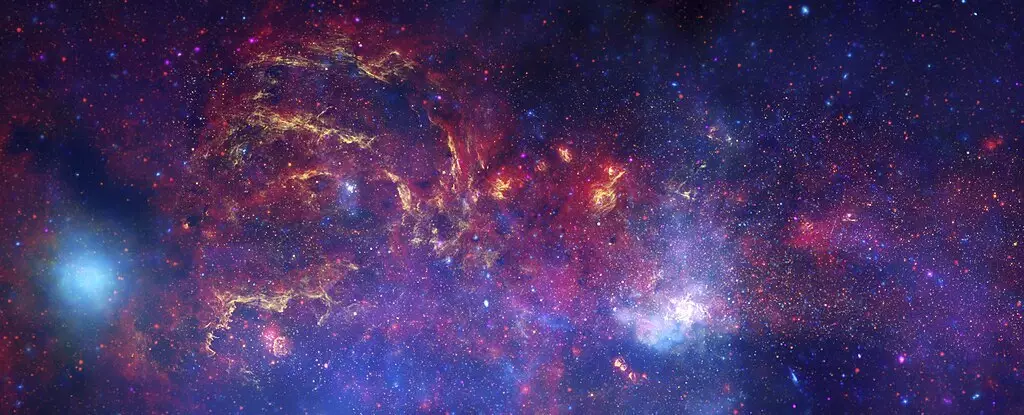Dark matter remains one of the most perplexing mysteries in modern astrophysics, representing about 85% of the universe’s mass yet eluding direct detection. Its existence is inferred from gravitational effects on galaxies and cosmic structures; however, its elusive nature makes it a focus of intense study. The latest research has honed in on the Central Molecular Zone (CMZ) of the Milky Way, an area dense with hydrogen molecules that could harbor clues about the nature of this enigmatic substance. The CMZ offers a unique environment where gas interacts under extreme conditions, presenting a multifaceted backdrop to explore the potential properties of dark matter.
The Central Molecular Zone: A Laboratory in the Skies
The CMZ is unlike any other region in our galaxy, housing nearly 80% of the Milky Way’s dense gas. Characterized by extreme cold and the rapid movement of gases that can reach hundreds of kilometers per second, this area is a prime location for studying cosmic phenomena. Here, molecular clouds serve not just as reservoirs of gas but also as stellar nurseries where star formation occurs. The intricacies and peculiarities observed in the CMZ have prompted scientists to question the fundamental interactions taking place within it and how these may link to the dark matter paradigm.
One notable aspect of the CMZ is its oddly positive charge in an environment typically dominated by neutral hydrogen. This phenomenon raises the question: what could be displacing electrons from the hydrogen atoms? The implications of this inquiry stretch far beyond mere curiosity; they open a window into exploring lighter forms of dark matter that may not conform to existing theoretical frameworks.
A New Perspective on Dark Matter: Light Particles and Unexpected Interactions
The concept of dark matter particles has generally gravitated toward heavier candidates, particularly weakly interacting massive particles (WIMPs). However, as theoretical physicist Shyam Balaji from King’s College London suggests, the ongoing research in the CMZ prompts a reevaluation of these assumptions. The notion of lighter dark matter particles, which could interact differently with ordinary matter, should not be dismissed. A lighter dark matter particle could potentially explain the unusual ionization occurring in the CMZ, a scenario that current models fail to accommodate adequately.
As particles collide and annihilate in space, lighter dark matter could lead to the creation of charged particles in sufficient quantities to ionize surrounding gases, resulting in the charged hydrogen clouds that have baffled scientists for decades. This new perspective places the search for dark matter within a broader framework, allowing for the possibility of particles that are less massive and even less interactive with the visible universe.
A Call for Broader Investigations: Rethinking Dark Matter Research
Current dark matter research often relies on experiments that are terrestrial, waiting for an elusive interaction to occur. Balaji’s perspective challenges scientists to reconsider their methodologies, advocating for a more expansive approach. Instead of confining the search to specific particle characteristics, researchers should explore a diverse array of potential dark matter candidates and interactions. This shift of focus is essential, especially since experiments targeting conventional models have yielded limited success over the years.
The implications of promoting a lighter dark matter particle are profound—not only could it redraw the landscape of cosmological theories, but it could also shift the approach to understanding fundamental astrophysical processes. By expanding the search criteria, scholars may stumble upon unexpected phenomena that could rethink our understanding of the universe’s composition.
The Future of Dark Matter Research: From Speculation to Discovery
While the exploration of light dark matter remains speculative, the observations made in the CMZ pave the way for transformative advancements in the field. It remains critical, however, to back these hypotheses with rigorous data collection and experimental validation. More comprehensive explorations of cosmic phenomena and continued observations of unique environments like the CMZ are necessary.
As we delve deeper into the universe’s mysteries, the potential for uncovering dark matter in a lighter form could revolutionize our grasp of cosmology. The challenges ahead are significant, but the scientific community’s resolve to innovate in the face of uncertainty must remain steadfast. With a filament of hope connecting emerging theories and empirical scrutiny, humanity stands on the precipice of profound discovery, eager to unveil the secrets that dark matter has long concealed.

